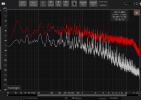For me, having 'flat' bass down to a low frequency is relatively unimportant. The number of full range speakers I've measured in studios which still have large + broad dips in their frequency response (at say, 55 or 65 Hz) due to boundary reflections is countless.
Subwoofers get a bad rep, but when they're integrated correctly into the main speakers (delay, phase response + correct freq. response, low distortion), they're totally transparent and can actually resolve the issues you have with room reflections.
By the way, there are maybe, 5 or 6
total busy working mix engineers here in the UK who are earning enough revenue from their work to actually fund the building of a room the correct shape & size to really not have any major problems. Most of us are having to make do with a space provided to us (and heavily treated), or a garden studio which is having to fit into the confines of what planning permission will allow
or the space available at the end of the garden. That's just the practical limitations of the industry at the moment, so subwoofers can be major problems solvers if they're applied correctly.
In terms of aspects of speaker performance, for me it's:
- Reliability
- High output capability without distortion (don't want to think that unpleasant sound coming from a port or distorting woofer is actually in the signal) - same performance loud when quiet
- No hiding dynamic issues, not sure why it doesn't show up in the measurements but I haven't found any measurements which seem to correlate with certain brands of speakers (Neumann I'm looking at you, and I own a load of them) hiding things in the signal which are perfectly audible on other speakers/headphones.
- Low distortion so I can hear what my reverbs/delays/ambiences are doing
- Wide and pretty even dispersion
- Low amounts of phase shift at the bottom of the pass-band so I can hear what any filters I'm putting in the low-frequencies are doing. We use a lot of plugins which introduce high-pass/low-pass filters in the signal to divide mixes up into separate frequency bands. If these stack up too much you can wind up really smearing the phase response of your kick drums/snare drums etc. Some speakers seem to reveal this, others don't.
- Relatively flat frequency response (once it's +/- a few dB or so you just learn what your speakers are doing)

